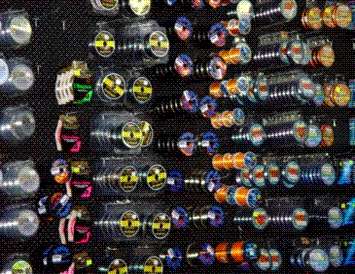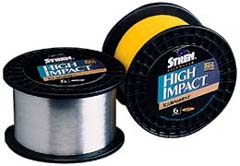|
The line is one of the direct links between you and the fish and in sport and game fishing it is also often the weakest. At the fish end, leaders and hooks are generally much stronger. The hardest decision and one of the most important of all is choosing line.
The line we specifically use is known as IGFA rated. However, IGFA itself does not rate any lines. It is up to each manufacturer to rate their own products. This rating ensures that the line is appropriate and that it will break under its rated breaking strain so it can be used confidently claiming records in that line class i.e. 8kg will break under 8kg. However, rarely is the label a true indication of the actual breaking strain.
Whenever you buy new line an effort should be made to get it independently checked by either at a game club or tackle shop that has a line testing machine.
There are various types of line on the market, and as it is such an important part of the system new types are continually under development but we can break them up into various categories. All these types have both desirable and undesirable characteristics. All of them are detrimentally affected over time with exposure to ultraviolet sunlight and fluorescent lights. They also suffer from exposure to salt water. When the water dries the minute salt crystals formed will cut into and weaken the line, though this over quite a long period of time and depends on how often it is used and how well it is rinsed at the end of the day.
 Stretch Lines Stretch Lines
These are mainly 100% nylon monofilament (one strand). They stretch from around 10 to 30%. There are many grades of nylon. The important factors of the better ones are, good abrasion resistance, great knot strength and they have a good recovery after loading i.e. high elasticity. The poorer qualities once stretched under load do not recover to their previous state and continually weaken under load. Friction is nylons worst enemy. Rods using nylon should ideally be fully rollered. Of all the types of lines used, nylon is the easiest to work with and the cheapest.
Due to the nature of nylon most of the stretch or elongation occurs at around a third of its breaking strain. Below that it is very much a soft elastic band with little power. Once you get above a third, the line continues to stretch right up until you reach its breaking point. Because of these characteristics, nylon is best used between 33% and 50% of its breaking strain to keep in contact and be in control when fighting fish.
Other types of line that have lower stretch are some nylons mixed with other synthetics which result in thinner than normal nylon as they are often pre-stretched and annealed to have a smoother harder surface, although when this surface is abraded the line fails easily.
Lines that include other materials such as titanium, carbon, fluorocarbon and other additives are also available and have a much lower stretch ratio than normal nylons. Nonetheless, these types of lines may have other drawbacks such as being stiff and or low knot strength.
Low Stretch Lines
The main line in this category is Dacron which is a hollow braided synthetic made up of many individual strands. Its low stretch, only about 2% is a great advantage in staying in contact with a fast-moving tough fish. Low stretch can be a disadvantage in that hooks are easily pulled as it jerks tight on a fish that changes direction or shakes its head. It is certainly much harder to keep pressure on a fish with low stretch lines than with nylon.
The greatest problem with Dacron is it is very fragile and easily damaged. It is most often used with a nylon top shot. The length of nylon is usually over 50 meters so that in normal line setting and close fights the Dacron does not come into play and remains in perfect condition on the spool.
 However, when you need pulling power on a fish that is running deep or being stubborn the Dacron is there to help put some direct pressure on the fish. Dacron is best joined by splicing Dacron to Dacron, or if connecting to nylon then the nylon is passed inside the hollow Dacron and then bound. Knots and top-shots are covered in detail in the chapter called "Connections". However, when you need pulling power on a fish that is running deep or being stubborn the Dacron is there to help put some direct pressure on the fish. Dacron is best joined by splicing Dacron to Dacron, or if connecting to nylon then the nylon is passed inside the hollow Dacron and then bound. Knots and top-shots are covered in detail in the chapter called "Connections".
All braided lines are far more tolerant of friction than nylon which is relevant if not using rollered rods; yet none of them are as forgiving to abrasion as plain nylon.
Non Stretch Lines
The greatest recent developments have been in these lines, known as braided lines, spectra, Kevlar etc. This group of lines has virtually no stretch giving direct contact to the fish, you can feel the slightest movement at the other end.
These lines are also very thin allowing you to put massive amounts of line on a reel or use smaller reels than with the other lines to fit 1,000 yards. However, smaller reels do have the same gearing as larger ones and are not as powerful.
Non-stretch lines have some pretty major disadvantages in normal trolling situations some of which are similar to those of Dacron but these are more intensified. They are very difficult to join to other lines and knot to terminal tackle such as snaps and swivels whilst maintaining line class.
The non-stretch also is very hard on the angler as the only cushioning is through the rod, a large fish shaking its head two feet jerks the line, rod and angler the same distance. Longer softer rods can compensate for this, but with these, it is more difficult for the angler to apply the same drag as possible with the other lines on shorter rods. The non-stretch also means there is no cushioning of the line relative to spool inertia, i.e. the pressure comes on 100% immediately, therefore lower drag settings are necessary to prevent break offs.
Deciding which type of line or combination to use is one of the hardest decisions. Generally in lighter line classes under 50lb full spools of nylon are adequate as nylon is cheap to replace especially on stand-up fishing, the angler has the power to pull the stretch out of the line and stay in contact with the fish. On heavier line classes, especially chair rods or heavy stand-up, Dacron with nylon top shots certainly is a good system for applying as much pressure as possible.

|





 Stretch Lines
Stretch Lines However, when you need pulling power on a fish that is running deep or being stubborn the Dacron is there to help put some direct pressure on the fish. Dacron is best joined by splicing Dacron to Dacron, or if connecting to nylon then the nylon is passed inside the hollow Dacron and then bound. Knots and top-shots are covered in detail in the chapter called "Connections".
However, when you need pulling power on a fish that is running deep or being stubborn the Dacron is there to help put some direct pressure on the fish. Dacron is best joined by splicing Dacron to Dacron, or if connecting to nylon then the nylon is passed inside the hollow Dacron and then bound. Knots and top-shots are covered in detail in the chapter called "Connections".